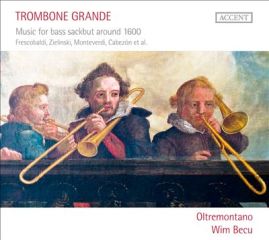Trombone Grande (Oltremontano) [2012]
Trombone Grande (Oltremontano) [2012]

1. Girolamo Alessandro Frescobaldi: In partitura il primo libro delle canzoni Canzona No. 7, "detta la Superba" 2. Giovanni Battista Fontana: Sonata Terzadecima 3. Bartolomeo de Selma y Salaverde: Canzoni fantasie et correnti da suonar No. 23. Canzon per due Bassi 4. Giovanni Pierluigi da Palestrina: Tota pulchra es (arr. G. Bassano) 5. Claudio Monteverdi: Selva morale e spirituale (arr. for chamber ensemble) 6. Mikolaj Zielenski: Communiones totius anni: Fantazja II 7. Francesco Rognoni Taeggio: Selva de varii passaggi: Susana d'Orlando 8. Il partitura il primo libro delle canzoni: Canzona No. 22, "detta la Nicolina" 9. Giovanni Martino Cesare: Musicali melodie per voci et instrumenti: La Hieronyma alla quinta bassa 10. Communiones totius anni: Viderunt omnes 11. In partitura il primo libro delle canzoni: No. 27. Canzona, "detta la Diodata" 12. Giovanni Paolo Cima: Concerti ecclesiastic: Sonata per cornetto e trombone 13. Gioseffo Guami: Canzonette francese: L'accorta 14. Communiones totius anni: Tu es Petrus 15. Antonio de Cabezon: Obras de Musica: Benedicta es Regina coelorum Oltremontano (Ensemble) Kris Verhelst (organ) Ellen Schafraet (harp) Rainer Zipperling (vocals) Andrea Baur (chitarrone) Wim Becu (bass trombone, conductor)
No fanciful programs here. This is simply music emphasizing the bass sackbut, the so-called Read more trombone grande , composed around 1600. It was at the time among the most popular of ceremonial instruments, both for noble and civic use, as numerous surviving inventories and payment schedules of the period attest. These things change, of course, and by the end of the 17th century the entire trombone family had faded away—not to reappear on the international stage until 100 years later, in a different role, associated with the tonal expansion of the modern orchestra. (Both Gluck and Mozart set the trombone to accompany Don Giovanni on his trip to hell, but the instrument had a two-way ticket.)
But for all its popularity at the height of its earlier fame, the point needs to be made that much of the music performed on the instrument wasn’t written specifically for it. This could easily be forgotten with a cursory examination of this album, since the title doesn’t refer to arrangements, and every piece listed in the liner notes has its publication date listed, along with the instrumentation, which invariably includes the bass sackbut. But for example, although it is stated that Fontana’s Sonata Terzodecima is for two cornetts, bass sackbut, and organ, the 1641 publication it comes from is made up of six sonatas for solo violin and continuo, and 12 further sonatas for two violins and continuo. Or again, Monteverdi’s Ab aeterno , though performed here on bass sackbut, chitarrone, and organ, was written as a motet with voice, and is usually performed by a bass singer with organ accompaniment. There is nothing wrong with the stylish arrangements heard here, but some word about their origins would have been welcome, as well perhaps as an essay about the difficulty of making transcriptions that work in context.
These do work. Though Oltremontano itself is patterned here on a so-called loud ensemble of the period with three sackbuts and two cornetts, variety is provided through smaller or larger groupings within the main ensemble, and with the selective addition of harp, organ, cello, and chiatarrone—sometimes in a subordinate role, sometimes as an equal partner. I don’t recall having ever heard a piece such as Cesare’s La Hieronyma , for bass sackbut and harp; and I’m not yet convinced this could be done in concert without the mere presence of the sackbut drowning out the harp. But it is all very stylishly done, with appropriate grace notes and figurations, and without any attempt to thicken textures or employ anachronistic harmonies.
The music is sober and serious, mixing freeform fantasias (themselves a mix of recitative and dance movements) with instrumental canzonas, and arrangements of vocal material. The performances by Oltremontano are expert. Hearing anywhere from one to three sackbuts (alto, tenor, and bass) played together with ease at moderate speed with the occasional very quick run, as in Guami’s L’accorta , is a treat. The sound is crisp, with enough room to give body to instrumental resonance, and the balance subtly adjusts for softer instruments. In short, this is a release of largely Italianate material that should greatly please fans of the genre, and of the music from this period. ---FANFARE: Barry Brenesal, arkivmusic.com
download: uploaded yandex 4shared mediafire solidfiles mega nornar








